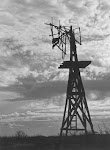52 Ancestors in 52 Weeks. Week #49 theme is "New
Horizons".

As our families arrived on the Atlantic Coast, some as early as the 1640s, they
must have been anxiously waiting for the view of the new land on the horizon.
They were so brave and ready for new experiences.
Choosing just one of these many early families, I would like
to chronicle our Frost family through more than two centuries of seeking
"New Horizons." The immigrant John Frost, our 9th great
grandfather, was born 1614 in England. He came first to New York with his
father, John, and then to New Haven CT by 1660s. His son, John, married
Mercy Paine there, and was the father of our 7th gt grandfather, Samuel Frost.
(We will find the surname of Paine again in this family line.) But first,
three generations of "Grandpa Samuels" lived in and around New Haven.
They would have lived through the struggles of clearing lands and surviving the
elements of a new world, including the French and Indian Wars. Then in
1754, our 4th gt grandfather, Isaac Frost, was born. His father fought in
the Revolutionary War, and they saw the new nation on the horizon.
Soon after the war, a Connecticut investment company made plans to populate the
Western Reserve which would include the new city of Cleveland, Ohio. Isaac and his family would be among the first
to make this venture. In fact, we believe that one of Isaac's sons,
Elias, surveyed the plats for the city of Cleveland. Another son, Johnson LymanFrost, our 3rd Gt Grandfather, married Oriana Paine, daughter of Seth Paine
(see, I told you that name would show up again). Oriana Paine Frost was the
first teacher in the Brecksville, OH area, and her name shows up in streets and
institutions. Oriana’s mother, Hannah Nash Paine, descended from a most
interesting line including Canada Waite, born in captivity in Canada when her
mother was kidnapped by Indians.
Old Isaac, and sons, Elias, and Lyman helped establish the town of Olmstead,
OH. The Frost name is still seen in the area. But even further horizons
beckoned, and in 1820, Johnson Lyman and family are found in St. Clair,
Michigan. Both Elias and Lyman had studied medicine, and although Lyman was not
a doctor, he used his knowledge to assist a doctor there. Then in 1830, he and
his family, including our 2 Gt Grandfather; Elias Carlos Frost, have moved
further into the frontier to Lacon County Illinois, near Peoria. As a
side note here, while in Lacon County, the Frosts lived about a mile from the
Graves family who went west as part of the Donner party. New horizons
were difficult if not impossible to conquer for many in that era.
When the wilds of Iowa opened for settlement, Lyman, whose wife had died in
Illinois, took his children, and traveled to Iowa City. As we look back,
it had been 200 years since the first Frost immigrants had arrived in North
America, and they had lived in 6 states, always moving westward. Iowa in
the 1840s was a new frontier, with forts and Indian confrontations. Many
settlers came with very little furniture and belongings, as they had to travel
by wagons pulled by oxen. But Iowa City grew up quickly into an area of businesses,
a militia, and academics. The University and debating societies were
established by 1847.
It was in Iowa City that our Frosts, Herringtons, Shafers, and McGills came
together through marriage. In the 70s, Elias and family, including daughter,
Eva, who married Daniel McGill, moved on to the western part of the state.
Our grandma, Harriett “Hattie” McGill, and her siblings were born in Audubon
County. According to family lore,
farming was difficult due to the weather and the plague of locusts or
grasshoppers. And at one point, the
general store in Audubon County, owned by Elias (also called Carlos) was robbed
by the "Crooked Creek Gang".
The brother-in-law of Elias (D.P. McGill's foster father), Daniel Shafer, had
helped to survey the state line of Nebraska; so Elias and Lucinda, along with
the elderly Lyman, moved on to Stuart, Nebraska. Lyman died there
according to the family Bible. His life alone had stretched from Connecticut to
Nebraska, and his very interesting personality has been recorded... another
story.
After a few years near Keya Paha County, Elias and family moved on west again,
to Chadron, Dawes County, Nebraska, around 1888. The McGills, still in
Iowa, headed for the newly opened territory of Oklahoma, with Daniel making the
Run of 1889. And Elias also moved his family to Oklahoma, where they lived and
died in Perry, Noble County.
Many descendants and relatives of these Frost families
followed their dreams even further west in the U.S. Their stories
include California during the gold rush days and later years, as well as other
states. We have so many families who made similar treks, but this is an example
of the pioneer spirit…seeking New Horizons.


.jpg)
.jpg)